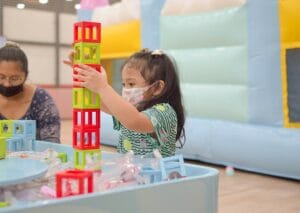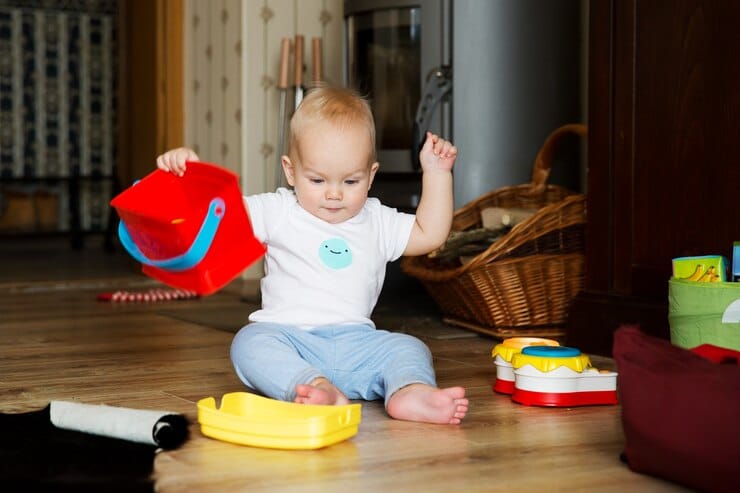Are you looking for fun and engaging ways to stimulate your child’s senses while encouraging creativity and exploration? DIY sensory toys are a fantastic way to provide sensory experiences for kids that are not only entertaining but also beneficial for their development. In this comprehensive guide, we’ll explore a variety of creative and easy DIY sensory toy projects that kids will love.
Creating homemade sensory toys can be a rewarding experience for both parents and children. Not only does it foster a sense of accomplishment and creativity, but it also allows for customization based on individual preferences and sensory needs. Using basic things found at home or doing bigger projects, there are many ways to make sensory toys. Let’s dive into the world of DIY sensory toy projects that are not only fun and engaging but also promote learning and development in children.

Why Do DIY Sensory Toys Matter for Kids Development?
Sensory play is crucial for children’s overall development, as it helps them explore and understand the world around them. DIY sensory toys play a significant role in enhancing various skills in children, including sensory processing, fine motor skills, cognitive development, and emotional regulation.
When children engage in sensory play with homemade toys, they are exposed to different textures, colors, sounds, and smells, stimulating their senses and encouraging curiosity and exploration. These experiences are essential for brain development and can have a lasting impact on a child’s ability to learn and interact with their environment. Moreover, DIY sensory toys cost less than store toys and can be made to fit each child’s needs. When children help make their own toys, they feel proud and learn to be creative and solve problems.
Research has shown that sensory play has numerous benefits for children, including improved focus and concentration, enhanced language and communication skills, and increased social interactions. By incorporating DIY sensory toys into a child’s daily routine, parents can help support their overall development and well-being.
Easy Ways to Make Homemade Sensory Toys for Kids
Making homemade sensory toys for kids doesn’t have to be complicated or expensive. With a little creativity and some basic household items, you can create a variety of engaging and stimulating sensory experiences for your child. Here are some easy ways to make homemade sensory toys that your kids will love:
- Sensory Bottles: Fill empty plastic bottles with colorful beads, sequins, or water to create mesmerizing sensory bottles that provide visual and auditory stimulation.
- Sensory Bags: Fill zip lock bags with hair gel, paint, or other squishy materials to create tactile sensory bags that children can squeeze and explore.
- Sensory Bins: Fill a plastic container with rice, beans, or sand and hide small toys or objects inside for children to discover through tactile exploration.
- Texture Boards: Glue various textured materials like sandpaper, fabric, and bubble wrap onto a board for children to touch and explore different textures.
- Sound Cylinders: Fill small containers with different materials like rice, beans, or bells to create sound cylinders that children can shake and listen to.
By incorporating these easy homemade sensory toys into your child’s playtime, you can provide them with valuable sensory experiences that promote learning, creativity, and exploration.
DIY Sensory Toy Ideas: Fun Learning at Home
Engaging children in sensory play at home can be both educational and entertaining. DIY sensory toys offer a hands-on approach to learning that encourages children to explore their senses and develop important skills in a fun and engaging way.
Here are some DIY sensory toy ideas that promote fun learning at home:
- Sensory Play Dough: Create homemade playdough using flour, salt, water, and food coloring to provide children with a tactile and creative sensory experience.
- Sensory Scavenger Hunt: Hide various sensory items around the house or yard for children to find using their sense of touch, sight, and hearing.
- Sensory Art: Encourage children to explore different textures and materials while creating sensory art projects like textured paintings or sensory collages.
- Sensory Storytelling: Use sensory props like scented playdough or textured fabrics to enhance storytelling and engage children in a multisensory learning experience.
By incorporating these fun and educational DIY sensory toy ideas into your child’s daily routine, you can help them develop important skills while fostering a love for learning and exploration.
Budget-Friendly DIY Sensory Toy Projects for Kids
Creating budget-friendly DIY sensory toys for kids is a great way to provide engaging and stimulating sensory experiences without breaking the bank. With a little creativity and resourcefulness, you can make a variety of sensory toys using inexpensive materials found around the house. Here are some budget-friendly DIY sensory toy projects that kids will enjoy:
- DIY Sensory Bottles: Repurpose empty plastic bottles and fill them with water, glitter, beads, or buttons to create mesmerizing sensory bottles that provide visual and auditory stimulation.
- Sensory Rice Bin: Fill a plastic container with colored rice and hide small toys or objects inside for children to search for and explore through tactile play.
- Homemade Sensory Playdough: Make playdough at home using flour, salt, and water, and add food coloring or scents to create a sensory-rich play experience for children.
- DIY Sensory Bag: Fill zip lock bags with hair gel, paint, or shaving cream to create squishy sensory bags that children can manipulate and explore.
- Texture Collage: Collect various textured materials like fabric scraps, sandpaper, and bubble wrap to create a tactile collage that children can touch and explore.
By incorporating these budget-friendly DIY sensory toy projects into your child’s playtime, you can provide them with valuable sensory experiences that promote learning, creativity, and exploration.
Upcycling Materials for Homemade Sensory Toys
Upcycling materials for homemade sensory toys is not only environmentally friendly but also a creative way to repurpose everyday items into engaging and stimulating play experiences for children. By using materials that would otherwise be discarded, parents can create unique sensory toys that promote sustainability and creativity. Here are some ideas for upcycling materials for homemade sensory toys:
- Cardboard Boxes: Turn cardboard boxes into sensory bins by filling them with rice, beans, or shredded paper for children to explore through tactile play.
- Empty Bottles and Jars: Repurpose empty bottles and jars to create sensory bottles filled with water, glitter, or small objects that provide visual and auditory stimulation.
- Fabric Scraps: Use fabric scraps to create sensory bags filled with different textures like cotton balls, rice, or beads for children to touch and explore.
- Plastic Containers: Turn plastic containers into sensory trays by filling them with sand, water, or shaving cream for children to engage in messy sensory play.
- Paper Tubes: Use paper tubes to create sensory shakers filled with beans, rice, or bells that children can shake and listen to for auditory stimulation.
DIY Sensory Toys for Child Growth and Development
DIY sensory toys play a crucial role in supporting child growth and development by providing valuable sensory experiences that stimulate learning, creativity, and exploration. From fine motor skills to emotional regulation, sensory play with homemade toys offers a wide range of benefits for children of all ages. Here are some ways DIY sensory toys can promote child growth and development:
- Fine Motor Skills: Activities like squeezing, pinching, and manipulating sensory toys help children develop their hand-eye coordination and fine motor skills.
- Sensory Processing: Sensory play with homemade toys allows children to explore different textures, sounds, and smells, helping them regulate their sensory inputs and responses.
- Cognitive Development: Engaging in sensory activities stimulates children’s cognitive abilities, including problem-solving, memory retention, and creative thinking.
- Emotional Regulation: Sensory play provides a calming and soothing outlet for children to express their emotions and develop self-regulation skills.
- Social Interaction: Sharing and playing with sensory toys in a group setting can enhance children’s social skills, including communication, cooperation, and empathy.
DIY Sensory Toys for Infants That Inspire Playtime
Sensory play is essential for infants as it helps them explore and make sense of the world around them. DIY sensory toys for infants provide valuable opportunities for sensory stimulation and exploration that support their cognitive, physical, and emotional development.
- Sensory Mobiles: Create a homemade sensory mobile using colorful ribbons, bells, and textured fabrics to hang above the crib for infants to gaze at and reach for.
- Sensory Balls: Make soft sensory balls using fabric scraps and stuffing to provide infants with tactile stimulation and encourage grasping and squeezing.
- Sensory Scarves: Tie different textured scarves to a wooden ring to create a sensory toy that infants can touch, feel, and explore during tummy time.
- Sensory Sound Bottles: Fill empty plastic bottles with rice, beans, or bells to create sensory sound bottles that infants can shake and listen to for auditory stimulation.
- Sensory Mirror: Place a baby-safe mirror in a sensory basket filled with soft fabrics, textured balls, and other sensory items for infants to engage with during playtime.
Sensory DIYs Made Simple: Easy Homemade Toys for Relaxation and Engagement
Creating simple DIY sensory toys for relaxation and engagement is a great way to help children unwind, destress, and focus their attention on calming sensory experiences. These homemade toys provide a soothing and enjoyable outlet for children to engage with their senses in a peaceful and meditative way.
Here are some sensory DIYs made simple:
- Sensory Bottles with Glitter: Fill clear plastic bottles with water, glitter, and beads to create mesmerizing sensory bottles that children can shake and watch for relaxation.
- Sensory Calming Jars: Make calming jars using water, glitter glue, and food coloring to create soothing visual displays that help children relax and unwind.
- Sensory Lavender Playdough: Add lavender essential oil to homemade playdough to create a calming and aromatic sensory experience for children to knead and shape.
- Sensory Breathing Balls: Use balloons filled with flour or rice to create sensory breathing balls that children can squeeze and release to practice deep breathing techniques.
- Sensory Relaxation Tunnels: Create a cozy sensory tunnel using fabric and cushions for children to crawl through and relax in a quiet and calming space.
FAQ
Q: Are DIY sensory toys safe for children? DIY sensory toys can be safe for children as long as parents use non-toxic materials, supervise playtime, and ensure that toys are age-appropriate and free from choking hazards.
Q: How can sensory play benefit children with special needs? Sensory play can provide valuable sensory input and regulation for children with special needs, helping them develop coping strategies, improve focus, and enhance communication skills.
Q: How can parents encourage children to engage in sensory play with homemade toys? Parents can encourage children to engage in sensory play with homemade toys by modeling play behavior, providing positive reinforcement, and creating a supportive and non-judgmental play environment.
Q: What are some signs that a child may benefit from sensory play with homemade toys? Signs that a child may benefit from sensory play with homemade toys include seeking out sensory input, displaying sensory-seeking behaviors, and showing a preference for certain textures, sounds, or smells.



